‘Digital and print is an and and proposition for libraries’, said Graham Jefcoate during the special collections session. But the budgets have not increased. So how should we allocate resources? How should we prioritize?
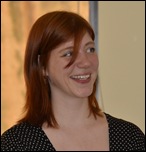 The Dutch KB has been working on a model that takes an integral view at printed and digital collections. The model can help decide what to spend our money on. At LIBER it was presented by Sophie Ham (photo left) and Tanja de Boer. As it has not been published yet, I gladly offer it here with some detail, because I think it can really help libraries make tough decisions (slides courtesy of Sophie Ham).
The Dutch KB has been working on a model that takes an integral view at printed and digital collections. The model can help decide what to spend our money on. At LIBER it was presented by Sophie Ham (photo left) and Tanja de Boer. As it has not been published yet, I gladly offer it here with some detail, because I think it can really help libraries make tough decisions (slides courtesy of Sophie Ham).
The model rates the value of (parts of) collections to determine which ones should be conserved or preserved with priority. Here are the rating criteria:
Primary criteria:
Secondary criteria:
And this is how the process works:
Multiplying primary and secondary criteria might look like this (just an example):
Sophie gave two extreme examples of how such a value assessment can turn out. This example concerns printed versions. Obviously, newspapers score higher on informational value and medieval manuscripts score higher on uniqueness and historic value.
|
| Newspapers | Medieval manuscripts |
| Informational value | 8 | 5 |
| Aesthetic value | 2 | 9 |
| Historic value | 3 | 9 |
| Use | 8 | 3 |
| Uniqueness | 4 | 10 |
| Condition | 2 | 8 |
| TOTAL | 27 | 44 |
What happens when these collections are digitized? Some values are transferred to the digital copy (e.g., much of the use and informational value for newspapers), but other values cannot be transferred (e.g., the uniqueness of a medieval manuscript). As Claudia Fabian of the Bayerische Staatsbibliothek demonstrated, the use value of a physical object may even increase when it is digitized, because more people become aware of its existence and become interested.
And here is the end result of this (extreme) example:
As you can see, the value of the physical medieval manuscript has remained unchanged, whereas some of the value of the printed newspaper collection has been transferred to the digital copy, especially the use value; the KB’s online newspaper database is in great demand by users of all kinds in the Netherlands.
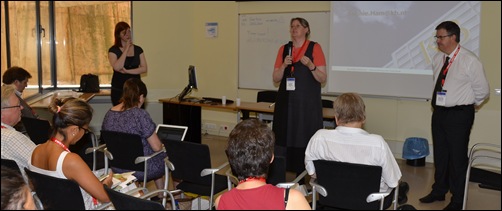 Discussing the KB model, from the left: Sophie Ham, Claudia Fabian and workshop chair Graham Jefcoate.
Discussing the KB model, from the left: Sophie Ham, Claudia Fabian and workshop chair Graham Jefcoate.
So, if push comes to shove, and painful decisions have to be made about whether to build new stacks for physical newspapers or invest in expanding the e-Depot that holds the digital newspapers, this (limited) analysis clearly points in the direction of investing in the e-Depot and perhaps deciding to keep only representative selections of printed newspapers.
Obviously, lots of questions remain. At what granularity should one assess collections? How can one make the assessments as objective as possible?, etc. But it is a promising beginning. If you want to know more or contribute to developing the model, please get in touch with sophie.ham@kb.nl.
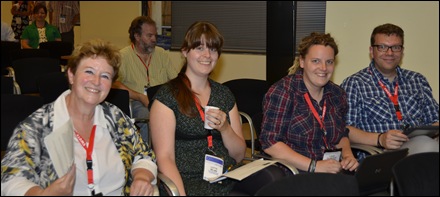 KB colleagues at Sophie’s presentation: from the left, Els van Eijck van Heslinga, Lotte Wilms, Lieke Ploeger, Victor-Jan Vos.
KB colleagues at Sophie’s presentation: from the left, Els van Eijck van Heslinga, Lotte Wilms, Lieke Ploeger, Victor-Jan Vos.
Value shift: cool conference bag being put to alternative use. Those with short legs thank the sponsors for the abundance of printed promotional material.




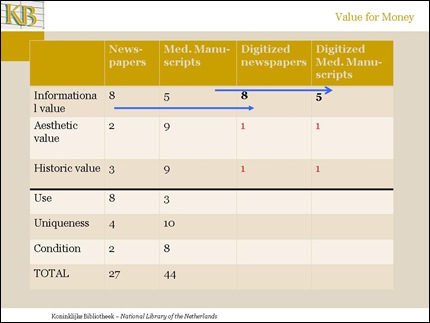

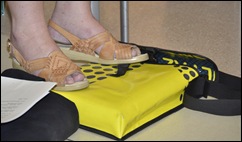
2 opmerkingen:
I have been following your blog since the ANADP conference and I just wanted to tell you how informative and helpful it has been.
I work in a medium sized public library and I really want to keep us informed on what is going on in the world of digital preservation, so I just wanted to send you a little note and say thank you for your time and attention to detail in your coverage of these events.
Thanks so much, Susanna. Being read is the best compliment a blogger can get!
Een reactie posten